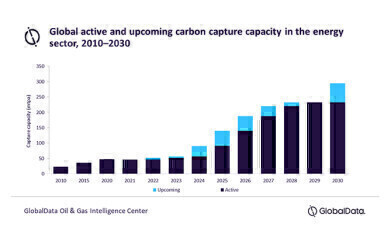Air Clean Up
Carbon capture and storage will be instrumental in reducing global carbon emissions.
Apr 05 2023
Carbon capture and storage (CCS) is an emission mitigation technology that will play a critical role in limiting global warming and will be instrumental in decarbonizing hard-to-replace industries, such as gas-fired power plants, says GlobalData. However, the leading data and analytics company notes that despite CCS supplementing renewable energy, hydrogen, and nuclear power in curbing global carbon emissions, high costs will hinder its adoption.
According to GlobalData’s report, ‘Carbon Capture and Storage (CCS) – Thematic Intelligence’, over 30 commercial-scale CCS projects were active globally as of October 2022, with a cumulative capture capacity of around 40 mtpa. In the last two years alone, many oil and gas and power producers have unveiled plans to install CCS units within their facilities to mitigate emissions. Assuming that all the proposed projects come online, the global CCS capacity in the energy sector could rise to around 130 mtpa in 2025 and then expand further in the next five years to nearly 300 mtpa by 2030.
Ravindra Puranik, Oil and Gas Analyst at GlobalData, comments: “At present, around 300 industrial sites are being evaluated for installing carbon capture technologies. This includes over 160 oil & gas and hydrogen production facilities that are expected to start capturing CO2 by 2030. Power plants and biorefineries add another 100 to this count, while cement, iron & steel, and direct air capture plants make up the remaining.”
In its Sixth Assessment Report released in March 2022, the Intergovernmental Panel on Climate Change (IPCC) suggested several pathways to achieve the goal of restricting global warming to under 2° Celsius from pre-industrial levels. The majority of these involved CCS. Leading oil and gas players have taken a keen interest in CCS technology development to support their net-zero goals. However, their efforts for mass deployment of CCS are largely deterred by the costs incurred to set up and operate these plants.
Puranik continues: “The pace of CCS adoption is hindered by high costs and identification of storage sites for the permanent injection of CO2. These challenges could be overcome in due course with technological advancement. Until then, government incentives, such as in the US, will be essential in the deployment of CCS in industries.”
The processes involved in CCS—gas separation, compression, transportation, and injection in an underground formation—are familiar concepts to executives in the oil and gas industry. Oilfield workers have the necessary skillsets and technological know-how to implement these processes.
Puranik concludes: “Many companies, including ExxonMobil, Occidental, and Equinor, are already using CO2 removal technologies in their facilities. This makes them strong contenders in leading the global CCS market. ExxonMobil and Equinor are at the forefront in decarbonizing key industrial clusters in the US and Norway, respectively, while Occidental is playing an instrumental role in the commercialization of direct air capture CCS plants.”
Events
WEATHER • CLIMATE • WATER / EARTH OBSERVATIONS / GREEN ECONOMY
Oct 29 2024 St. Petersburg, Russia
Oct 30 2024 Hong Kong
Nov 05 2024 Toronto, Canada
Nov 06 2024 Ho Chi Minh City, Vietnam
Nov 12 2024 Valencia, Spain













